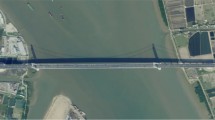Abstract
Based on health monitoring system installed on steel truss arch girder of Dashengguan Yangtze Bridge, temperature differences from cross sections of top chord, arch rib chord, bottom chord and diagonal web member are specially monitored and researched through extreme value analysis, correlation characteristics analysis and probability statistics analysis. On this basis, yearly extreme values of temperature differences are simulated for the whole service period by combination method of Monte-Carlo simulation and Newton iteration, and furthermore standard values of temperature differences with exceeding probability of 2% are calculated by generalized extreme value distribution function. And main research results reveals that: (1) obvious temperature differences actually exist in the cross sections of chord members and diagonal web member; (2) uniform temperature action actually exists in cross sections of chord members and diagonal web member at night, and temperature differences in the daytime commonly increase under solar radiation; (3) temperature differences from cross sections of top chord, diagonal web member and arch rib chord increase or decrease simultaneously; (4) Weighted sum of three Weibull distribution functions can well describe cumulative probability characteristics of daily extreme samples; (5) generalized extreme value distribution function can well describe cumulative probability characteristics of simulated yearly extreme values, and correlation scatter plots between calculated standard values and monitoring extreme values show good linear relationship.
Similar content being viewed by others
References
Barsotti, R. and Froli, M. (2000). “Statistical analysis of thermal actions on a concrete segmental box-girder bridge.” Proc. Structural Engineering International: Journal of the International Association for Bridge and Structural Engineering, Vol. 10, Int. Assoc. for Bridge and Structural Eng., Eth-Honggerberg, Italy, pp. 111–116.
BS EN 1991-1-5 (2003). British Standard, Eurocode 1: Actions on structures. Standards Policy and Strategy Committee, London.
Cao Y. H., Yim. J., and Zhao, Y. (2011). “Temperature effects on cable stayed bridge using health monitoring system: a case study.” Structural Health Monitoring-An International Journal, 10(5), pp. 523–537.
Ding, Y. L. and Wang, G. X. (2013). “Estimating extreme temperature differences in steel box girder using longterm measurement data.” Journal of Central South University, 20(9), pp. 2537–2545.
Ding, Y. L., Zhou, G. D., Li, A. Q., and Wang, G. X. (2012). “Thermal field characteristic analysis of steel box girder based on long-term field measurement data.” International Journal of Steel Structures, 12(2), pp. 114–125.
Guo, T., Li, A. Q., and Li J. H. (2007). “Influence of temperature and increasing traffic flow on the fatigue damage of welded bridge decks.” Key Engineering Materials, 348, pp. 341–344.
Long, P. H., Zhang, M. H., and Chen, W. Z. (2010). “Analysis of temperature stress for concrete box girders cracking.” Proc. 2010 International Conference on Mechanic Automation and Control Engineering, IEEE Computer Society, China, pp. 1590–1594.
Mosavi, A. A., Seracino, R., and Rizkalla, S. (2012). “Effect of temperature on daily modal variability of a steelconcrete composite bridge.” Journal of Bridge Engineering, ASCE, 17(6), pp. 979–983.
Sun, L. M., Zhou, Y., and Li, X. L. (2012). “Correlation study on modal frequency and temperature effects of a cable-stayed bridge model.” Proc. 2nd International Conference on Structures and Building Materials, Vol. 446, Trans Tech Publications, China, pp. 446–449.
TB10002.1 (2005). Fundamental code for design on railway bridge and culvert. China Railway Publication, Beijing.
Yu, X. L., Ye, J. S., and Wu, W. Q. (2011). “Cracking damage of long span prestressed concrete box girder bridges.” Journal of Harbin Institute of Technology, 43(6), pp. 101–104.
Author information
Authors and Affiliations
Corresponding author
Rights and permissions
About this article
Cite this article
Gaoxin, W., Youliang, D. Research on monitoring temperature difference from cross sections of steel truss arch girder of Dashengguan Yangtze Bridge. Int J Steel Struct 15, 647–660 (2015). https://doi.org/10.1007/s13296-015-9011-9
Received:
Accepted:
Published:
Issue Date:
DOI: https://doi.org/10.1007/s13296-015-9011-9




